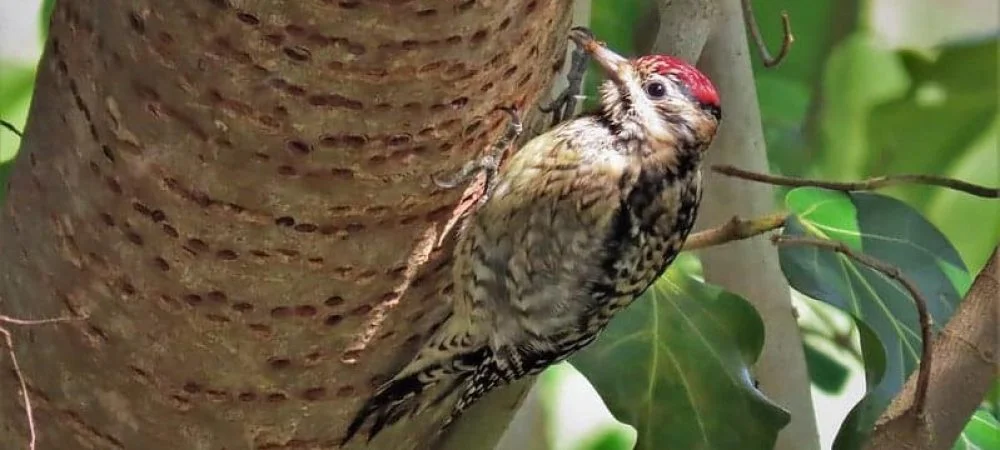
Want to learn more? Take a look at the North American Guide to Woodpeckers
The state of Pennsylvania is known for its wide range of weather that can appeal to all kinds of different animals.
In the warmer months, Pennsylvania is known to be humid and hot, making it appeal to many different kinds of animals that like to luxuriate in the warmth.
However, its winter contrasts this greatly with a sharp and unpleasant cold that can sometimes drive animals to move further south.
Birds in particular spend a great deal of time in this beautiful state, with a total of eight kinds of woodpeckers calling Pennsylvania home on a semi-regular basis.
Take a look at our article on How to Attract Woodpeckers?
What Woodpeckers can be seen in Pennsylvania?
Table of Contents
1. Red-bellied Woodpecker
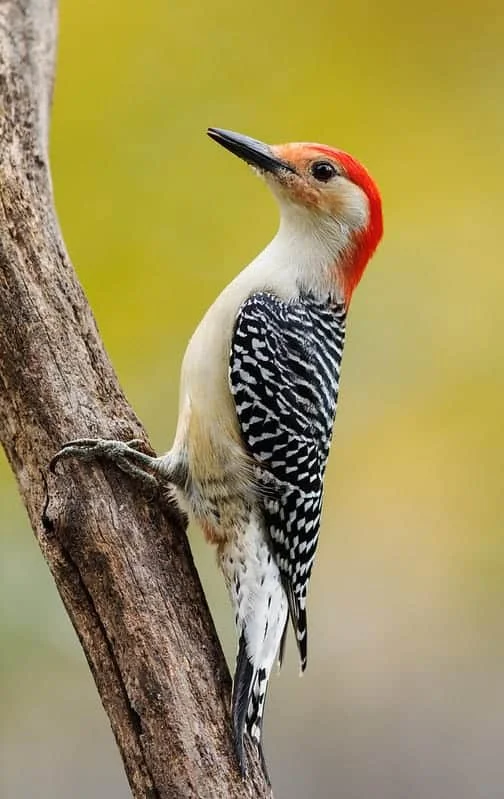
Wingspan
15-18 inches
Weight
2.65 ounces
Life Expectancy
12 years
Diet
Insects
The Red-Bellied Woodpecker is a funny bird with a fairly confusing name.
Though this particular bird has a very obvious and bright red head, its belly is relatively underwhelming by comparison.
The Red-Bellied Woodpecker has a light pink color on its stomach, but even this isn’t a great way to spot them because it is so commonly covered when they cling to trees as they hunt.
These birds are known for their dedicated monogamy and partnerships. The birds come together for mating and actually select their nests together as a couple.
Spotting the Red-Bellied Woodpecker is a year-round affair in Pennsylvania.
These adorable birds with their vibrant heads can be spotted quite actively throughout the year, but are known to spend more of their time fluttering about during mating season in winter.
You can see them out and about seeking out mates before settling down in later seasons.
The Red-Bellied Woodpecker is not the most common woodpecker in Pennsylvania, but it can absolutely be spotted there.
This particular bird prefers woody areas that are known for their dense plants and easy food supply.
Since these birds generally eat nuts and berries, they prefer to enjoy spending their time in areas where these foods are more readily available.
2. Downy Woodpecker
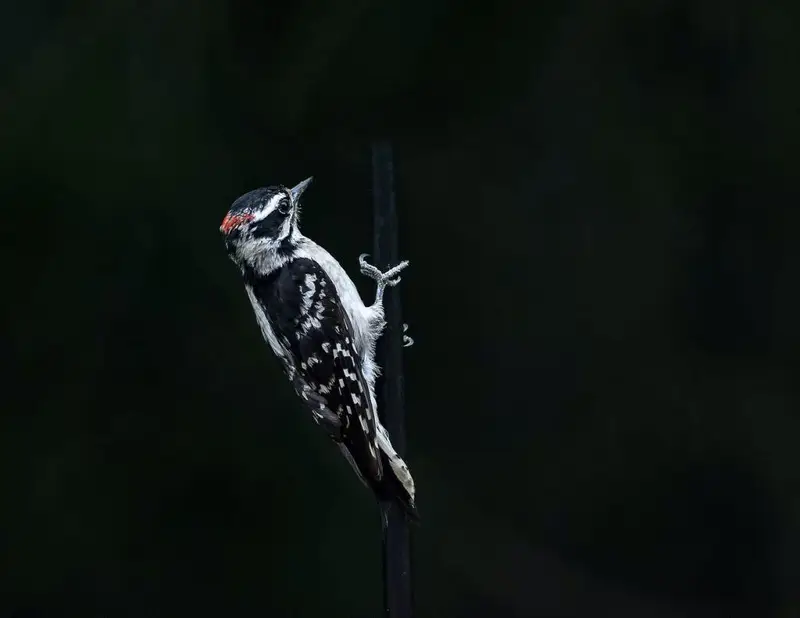
Wingspan
3.27 to 4.13 inches
Weight
0.75 to 1 ounce
Life Expectancy
12 Years
Diet
Insects & Non-insect arthropods
The Downy Woodpecker is often considered to be the smaller younger cousin of the Hairy Woodpecker.
It is black and white in color, small in size, and known for its incredibly short lifespan.
These adorable birds waste no time making the most of their lives, and they know what they like.
Though the odd Downy Woodpecker has been known to enjoy a nesting box, the majority are found exclusively in deadwood trees, which are their preferred area to nest.
This particular woodpecker is nonmigratory in nature, so it can be found year-round in the Pennsylvania area.
These birds are more active in mating season up until the eggs come. They are known for their unique co-parenting approach.
If you notice that the local Downy Woodpeckers seem to have disappeared, they might be spending time tending to their eggs.
Finding these birds is a matter of going out into nature. Since they prefer to nest and hunt in deadwood, it is not surprising to find them fairly deep within a forest.
The Downy Woodpecker is known for spending its time clinging to deadwood, actively foraging for all manner of insects.
They can also be spotted hopping along the ground looking for berries and other delicious treats.
3. Hairy Woodpecker
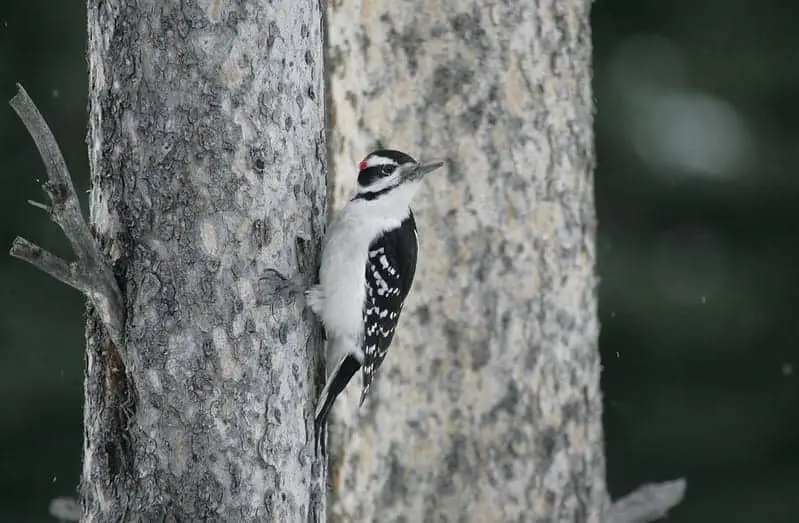
Wingspan
15 inches
Weight
1.4 to 3.4 ounces
Life Expectancy
15 years
Diet
Wood-boring insects & tree sap
The Hairy Woodpecker is an adorable little bird that is known for its high-pitched call that is composed of a unique series of notes.
The Hairy Woodpecker is a black and white bird that is a little round in shape. You can spot the males because of their unique splash of red that makes them notably different from the females, who are only black and white in color.
They are known to sing songs and do traditional drumming sounds when seeking a mate, making them fairly easy to locate if one is in the area.
In Pennsylvania, the Hairy Woodpecker is a constant resident that is known to spend its time in the state year-round.
Though some may travel to other interesting places, most of these birds find that Pennsylvania is a good place to stay, hunt, and nest.
You can spot them at any time of day, generally fairly low to the ground as they snatch up delicious food in the area.
To locate these birds, you will want to focus on the forested areas. These birds are quite partial to spending their time in trees and can easily be found in heavily wooded or even swampy areas within Pennsylvania.
They are also known to inhabit shared spaces near beaver ponds, parks, and the odd cemetery around the state.
4. Pileated Woodpecker
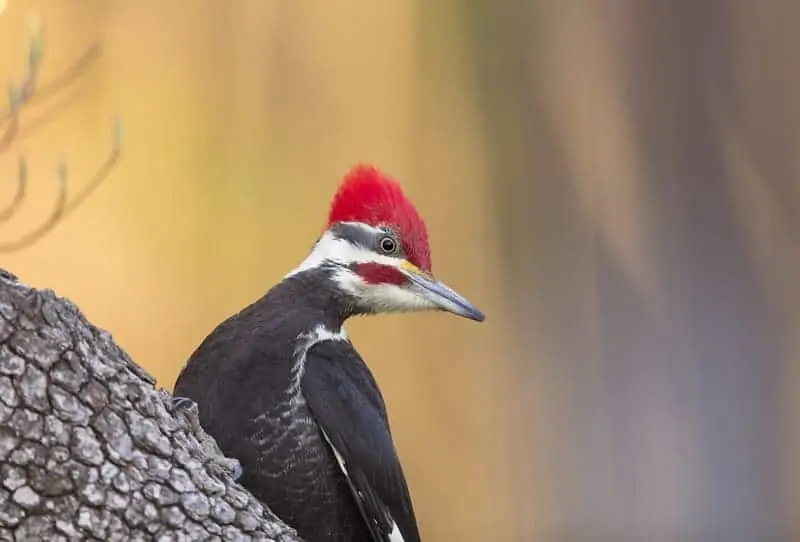
Wingspan
26 to 30 inches
Weight
8.8 to 14.1 ounces
Life Expectancy
13 years
Diet
Fruit, nuts & insects
The Pileated Woodpecker is a unique bird that is fairly easy to spot because of its signature red feathers atop its head.
This woodpecker stands out quite a lot with this vibrant appearance, making it easy to see them when they are actively flying about, as well as when they are nestled in a nice tree.
The Pileated Woodpecker is known for its unique homes, which are created from burrowing into tree cavities.
What makes them more interesting is that they are known to create multiple entrance points to their nest site.
This particular woodpecker is actually one of the largest woodpeckers around and it is known for making its home in Pennsylvania.
You can see these birds in winter and early spring more easily because they are more active during the mating season.
It is more common to see these birds actively flying around and creating a nesting space for the sake of their potential mates.
In Pennsylvania, these birds are more commonly found within a forested space.
They prefer wooded areas that offer a wide range of nesting sites and a good spread of delicious meals for them to enjoy.
The Pileated Woodpecker is also known to fly over large open areas or fields in search of good food to eat.
Their ideal space includes coniferous forests, making this an appropriate place to look for them.
5. Yellow-bellied Sapsucker
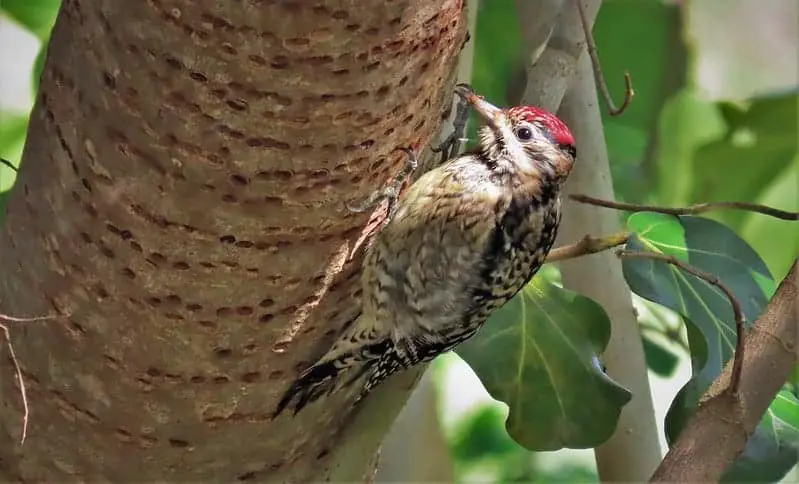
Wingspan
13 to 16 inches
Weight
1.5 to 1.9 ounces
Life Expectancy
7 years
Diet
Tree sap, insects & fruit
The Yellow-Bellied Sapsucker is a bird with an accurate name that few would appreciate.
Though it might sound like the person who named this bird was insulting it, the fact that this particular woodpecker has a yellow belly and does, in fact, drink sap from trees, makes it a fairly accurate choice in names.
For this bird, nesting is a unique process generally cared about by the male over the course of several weeks as they dig a cavity for a nesting space.
Though the Yellow-Bellied Sapsucker does not always migrate, it is known to depart Pennsylvania.
These birds tend to travel south when their natural habitat is too far north, and Pennsylvania makes the cut.
During the non-breeding season in the fall, these birds will leave Pennsylvania in search of softer and warmer lands that will keep them safe.
Outside of this, the birds can be found throughout the rest of the year. Some might even migrate shorter distances rather than leave Pennsylvania entirely.
Finding these birds in Pennsylvania is fairly simple if you know where to look because they are quite common in the state.
These birds prefer to spend their time near tree bark, where they will often spend time slurping up delicious sap that is full of nutrients.
They are partial to somewhat wooded areas, but can be found in the odd yard if you know how to bribe them.
6. Northern Flicker
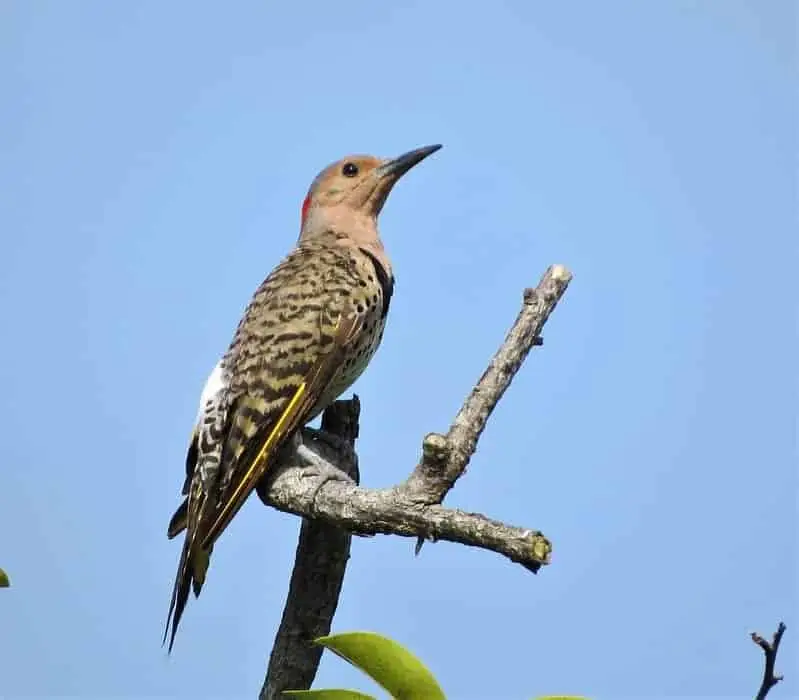
Wingspan
21.3 inches
Weight
6 ounces
Life Expectancy
9 Years
Diet
Insects, seeds, nuts & fruit
The Northern Flicker is a beautiful bird that is generally known for its unique appearance.
This little bird is covered in tell-tale spots with vibrant pops of color. The underside of their wings is metallic and beautiful, making them one to look out for when birdwatching.
They share the common woodpecker trait of drumming on objects to communicate with other woodpeckers in the area, including female woodpeckers.
These birds are unique for sharing duties among the happy mates, with both parties taking turns feeding and nurturing the young.
In Pennsylvania, the Northern Flicker is a much-loved and common bird visitor.
Though this species of bird is unique for its migratory nature, it is also known for its on-going presence in Pennsylvania.
In fact, over the last couple of decades, the Northern Flicker has been one of the most common woodpeckers in the state.
This common species is consistently about eating up annoying pests much to the delight of local residents. It can be found year-round, but this might change with the seasons.
Since the Northern Flicker is one of the more common types of woodpecker in Pennsylvania, it comes as no surprise that they can be found just about anywhere.
These birds are fairly common, particularly in wooded areas where they can happily build their nests.
These unique birds are known to spend time nesting in local trees and zipping around in search of food.
7. Red-headed Woodpecker
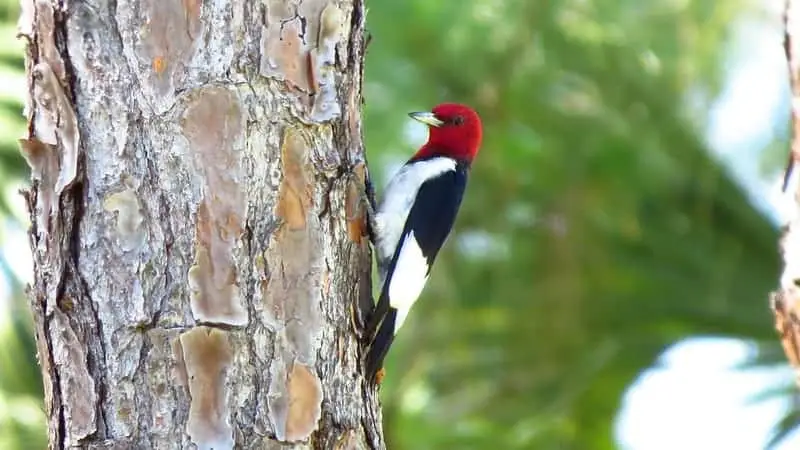
Wingspan
16 inches
Weight
2.5 ounces
Life Expectancy
9 Years
Diet
Insects & Berries
The Red-Headed Woodpecker is a beautiful bird with a black and white body and a bright red head.
They are most easily recognized because of their beautiful robin-like faces that do an excellent job of making them visible from a distance.
These adorable birds are known to enjoy nesting in cavities found in almost any kind of wooden structure.
Funny enough, they prefer non-living wood for their homes rather than live trees like most other woodpeckers.
In Pennsylvania, the Red-Headed Woodpecker is known for its short distance migration pattern. More often than not, these birds will hunker down in a location for a lengthy amount of time.
However, depending on the time of year, temperature, and food supply, they have been known to venture out into new places in search of something delicious to eat.
They will generally vacate northern parts of a state in search of warmer weather and more bugs.
In order to see the Red-Headed Woodpecker, you will generally want to head out into wooded areas.
These birds have a preference for plant-life and a rich abundance of delicious bugs to feast on, so the forest is an ideal spot for them.
On occasion, these birds have been known to visit local yards and bird feeders, particularly in the event that you live near a more natural habitat that they might be inhabiting.
8. Black-backed Woodpecker
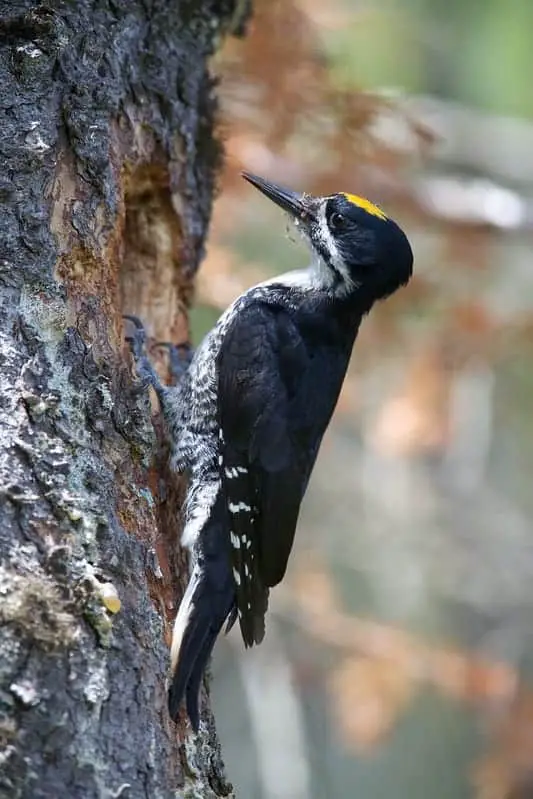
Wingspan
16 inches
Weight
2.5 ounces
Life Expectancy
8 Years
Diet
Wood-boring Beatles, fruit & nuts
The Black-Backed Woodpecker is a black and white woodpecker known for its fascination with small deadwood trees.
This woodpecker has a preference for nesting and foraging within small deadwood trees and can often be found in areas that have plenty of them.
Their propensity for burrowing into these trees makes them easier to find if you know where to look, but their nests can be fairly hidden unless you are really looking for them.
The Black-Backed Woodpecker is nonmigratory, though it has been known to move in the event winter gets too cold. Sometimes these birds will move out of forests and to lower elevations to dodge the cold.
You can most commonly see them in April and May when they are out seeking a new nest, but they can otherwise be found year-round.
These birds are known for their preference of staying put that separates them from many other woodpeckers.
Though they do seek new nests annually, they are known to stay in a single area for a long time because of their hunting method, which includes digging deep into dead trees to excavate larvae.
You can find these birds anywhere that there is deadwood. Since this is where they hunt and live, it is a signature of their territory.
Though the odd Black-Backed Woodpecker might nest in a live tree, they almost always seek out dead ones instead.
You can most commonly spot them in areas with a good balance of deadwood and live trees.

More Articles.
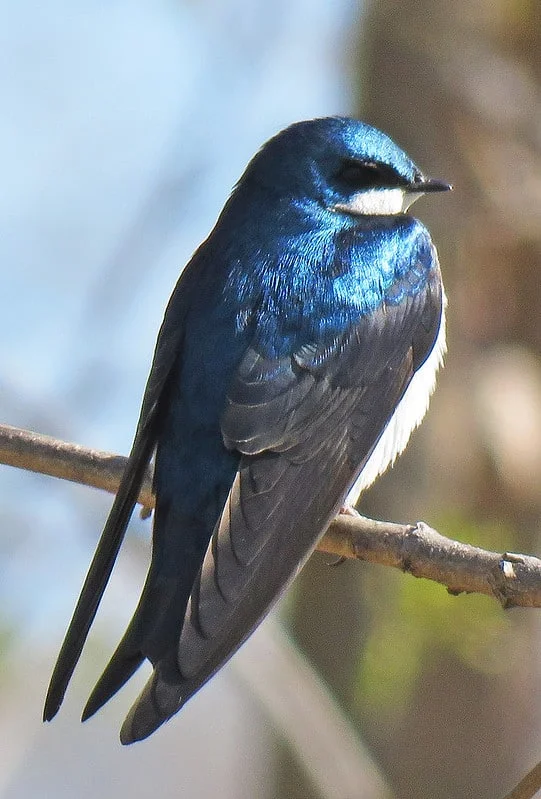
North American Birds with Blue Wings (13 Species with Pictures and Sounds)
North America is filled with many wonderful birds with blue wings – in fact, there
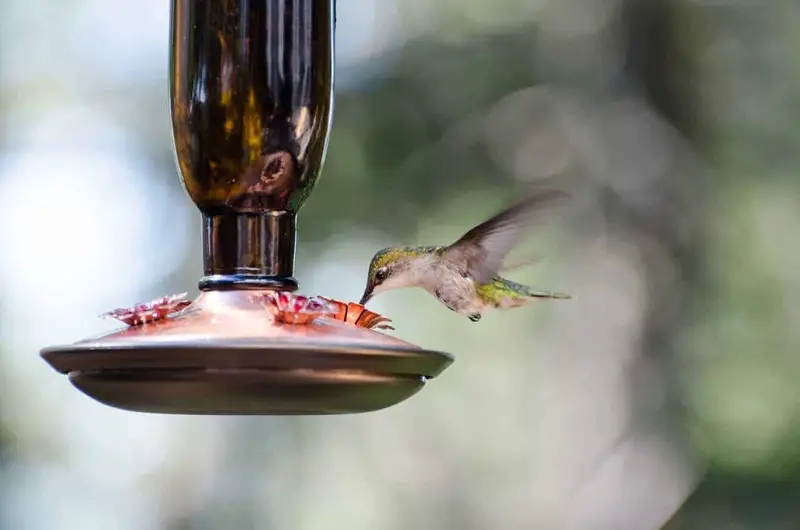
Best Hummingbird Feeders for 2020
Nectar bird feeders are well-known for attracting a variety of adorable birds and for saving

North American Birds with Orange Bellies (15 Species with Sound and Pictures)
North America is filled with many wonderful birds with orange bellies – in fact, there

About Us
We are avid bird-watchers who recently retired, allowing us more time to travel the world. Fortunately, we have managed to visit numerous countries around Europe, Asia, and America. Watching and photographing birds has been a passion for many years and we are making the most of the extra time on our hands!

I have a bird feeder and have 3 different breeds of woodpeckers and I looked them up, I live in PA and everyday I see the red bellied woodpecker I named him woody, 2 gila woodpeckers and ladder backed woodpecker that I named specs idk why but I did. And you don’t have the gila or ladder backed listed on here.